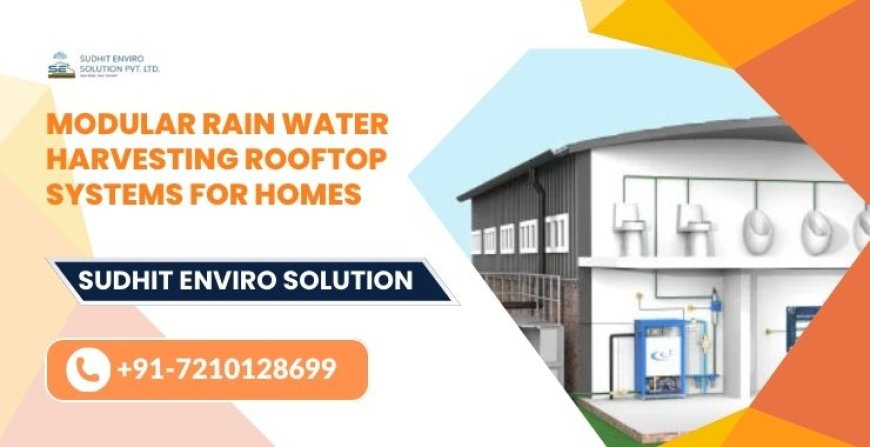Modular Rain Water Harvesting Rooftop Systems for Homes
Modular rainwater harvesting rooftop systems for homes are an effective, environmentally friendly, and cost-efficient way to conserve water.

In today's world, where water scarcity is becoming an increasingly pressing concern, utilizing every possible source of water is crucial for sustainable living. Rainwater harvesting (RWH) is one such method that can significantly contribute to water conservation efforts. Among the various types of rainwater harvesting systems, Modular Rain Water Harvesting Rooftop Systems have emerged as an innovative, efficient, and adaptable solution for homes. In this article, we will explore the importance of RWH, the advantages of modular rooftop systems, and how professional Rain Water Harvesting Installation Services can ensure a seamless installation process.
What is Rainwater Harvesting?
Rainwater harvesting is the practice of collecting, storing, and utilizing rainwater for various purposes. It involves capturing rainwater from surfaces like rooftops, filtering it, and storing it for later use. By tapping into a natural and renewable resource, rainwater harvesting reduces dependence on municipal water supplies, lowers water bills, and helps conserve precious freshwater resources.
In homes, rainwater can be used for various non-potable purposes such as gardening, flushing toilets, washing cars, and even for landscape maintenance. In some advanced systems, after proper treatment, rainwater can be used for potable purposes as well. The modular rooftop systems offer a reliable and cost-effective solution for homeowners looking to make use of this valuable resource.
Understanding Modular Rainwater Harvesting Rooftop Systems
Modular rainwater harvesting systems are designed to be highly flexible and adaptable, making them an excellent choice for homes with various roof types and sizes. These systems consist of interlocking components that can be easily expanded or modified based on specific requirements. The modular design makes it possible to customize the system to fit a variety of roof spaces, whether big or small.
Key Features of Modular Rain Water Harvesting Rooftop Systems:
- Adaptability: These systems can be adjusted to suit different roof layouts and sizes, ensuring maximum water collection efficiency.
- Scalability: Homeowners can start with a smaller setup and scale it up as their water harvesting needs grow.
- Ease of Installation: Modular systems are easier to install compared to traditional rainwater harvesting systems, reducing time and labor costs.
- Maintenance: These systems are designed for easy maintenance, with removable components that make cleaning and upkeep hassle-free.
- Reliability: With high-quality components, modular rooftop systems are built to last, ensuring a long lifespan and consistent performance.
Benefits of Modular Rain Water Harvesting Rooftop Systems
The adoption of modular rainwater harvesting systems comes with numerous benefits for homeowners, particularly in regions where water scarcity is an issue. Here are some key advantages:
-
Water Conservation: By collecting rainwater, homeowners can significantly reduce their reliance on municipal water supplies. This is especially important during dry spells or in areas where water supply is limited. Rainwater can be used for activities like washing cars, cleaning floors, and watering gardens, reducing the overall demand for tap water.
-
Cost Savings: Over time, the use of harvested rainwater can result in substantial savings on water bills. While the initial installation cost may seem significant, the long-term benefits far outweigh the investment. With modular systems, homeowners can even adjust the size of the system based on their budget and water needs.
-
Environmental Impact: Rainwater harvesting helps reduce the burden on the environment. By minimizing the use of groundwater and treated municipal water, homeowners contribute to sustainable water management practices. Moreover, reducing runoff from rooftops helps prevent soil erosion and flooding in urban areas.
-
Increased Property Value: As more homeowners seek eco-friendly and sustainable solutions, having a rainwater harvesting system can increase the value of a property. A well-maintained modular rainwater harvesting system not only contributes to sustainability but also demonstrates an environmentally conscious mindset, which is attractive to potential buyers.
-
Reliability: Modular systems are designed to be durable and reliable. With high-quality materials and components, these systems ensure that homeowners can consistently collect and use rainwater throughout the year. The modular design also allows for easy replacement of components if needed, ensuring long-term functionality.
Rainwater Harvesting Installation Service
While the benefits of modular rainwater harvesting systems are clear, proper installation is key to ensuring optimal performance. Rainwater Harvesting Installation Services play an essential role in setting up these systems efficiently and effectively.
Professional installation services come with the expertise and knowledge required to ensure the system is properly integrated with the home’s rooftop, downspouts, and storage tanks. Here’s why opting for an expert installation service is important:
-
Customized Design: Each home is unique, with different roof shapes, sizes, and configurations. A professional installation service ensures that the system is tailored to your specific needs. Experts assess the available rooftop space, the volume of rainwater that can be harvested, and the best placement for components like gutters, downspouts, filters, and storage tanks.
-
Optimal Performance: Installing a rainwater harvesting system involves more than just placing a tank under a downspout. Proper filtration, effective routing of water, and strategic placement of components are essential to maximize efficiency. An experienced installation team ensures the system is set up to function optimally, reducing the risk of clogs, contamination, and wasted water.
-
Compliance with Regulations: In some areas, local regulations govern the installation of rainwater harvesting systems. A certified rainwater harvesting installation service is familiar with these regulations and ensures that the system complies with building codes and safety standards. This not only guarantees the safety of the installation but also prevents any potential legal issues.
-
Long-Term Maintenance: Installation services often include guidance on the maintenance of the system, ensuring that homeowners understand how to properly maintain and clean the components. Additionally, many services offer maintenance packages that ensure the system continues to function effectively over the years.
-
Warranty and Support: Professional installation services often come with warranties and customer support. If issues arise with the system after installation, you can rely on the service provider to assist with repairs or maintenance. This gives homeowners peace of mind, knowing that their investment is protected.
Installation Process for Modular Rain Water Harvesting Systems
The installation of a modular rainwater harvesting system typically follows a series of steps:
-
Site Assessment: The first step involves a site visit from a professional team to assess the rooftop, the available space for components, and the specific water requirements of the household. This helps determine the optimal configuration for the system.
-
Design and Planning: Based on the site assessment, the team designs a customized rainwater harvesting solution. This includes determining the type and size of the system, the placement of gutters, filters, storage tanks, and other components.
-
Installation: Once the design is finalized, the installation process begins. This typically includes installing gutters, downspouts, filters, and connecting them to storage tanks. The modular system components are then assembled and configured to work seamlessly.
-
Testing: After installation, the system undergoes testing to ensure it is functioning properly. The team checks for any leaks, blockages, or inefficiencies and ensures that the system is ready for use.
-
User Training: Once the system is fully installed and operational, the homeowner is trained on how to use, maintain, and clean the system. This ensures the homeowner is equipped to care for the system and make the most of their rainwater harvesting efforts.
Conclusion
Modular rainwater harvesting rooftop systems for homes are an effective, environmentally friendly, and cost-efficient way to conserve water. With their adaptability, scalability, and reliability, these systems are well-suited to a wide range of homes, helping homeowners reduce their water bills, lessen their environmental impact, and contribute to a more sustainable future.
Opting for professional Rain water Harvesting Installation Service ensures that the system is properly designed, installed, and maintained for long-term efficiency. By investing in a modular rainwater harvesting system, homeowners can enjoy the benefits of abundant, free water while contributing to a greener planet.
What's Your Reaction?


















![[???????????????????????????? ???????????????? ????????????????????????] Can I Change My Name On Expedia Airlines](https://news.bangboxonline.com/uploads/images/202501/image_430x256_67915cce6df9e.jpg)


